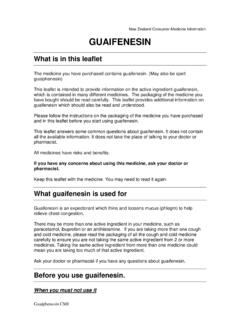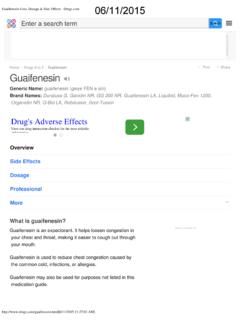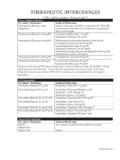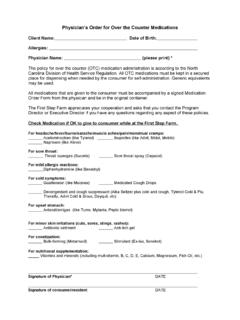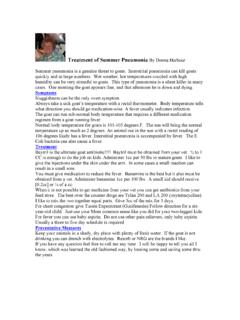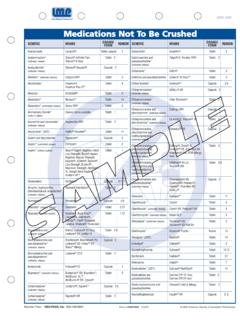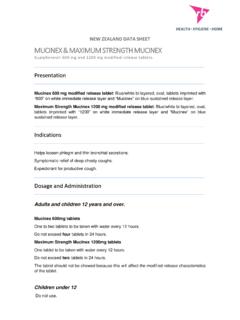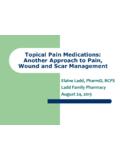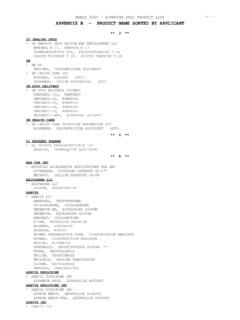Transcription of Guide to OTC Active Ingredients in the United States
1 Book Guide to OTC Active Ingredients in the United States Supplement to Pharmacy Today Table of Contents Regulatory Background and 1-2. A. Internal (Oral) 3. B. Cold, Cough, Allergy, Bronchodilator, and Antiasthmatic 4-5. C. Nighttime Sleep 6. D. Stimulants (Caffeine).. 6. E. 7-9. F. Analgesics, Anesthetics, Counterirritants, and Antipruritics (External Analgesics)..9-10. G. Skin Treatment 11-13. H. Hair Loss I. Topical Antiseptics and J. Anorectal K. Vaginal L. M. Otics (Ear Wax Removal Aids)..17. N. Oral Healthcare 17-18. O. Menstrual P. Q. Nicotine Replacement R. Weight Loss Your Health at Hand Book: Guide to OTC Active Ingredients in the United States October 2010.
2 Published annually by: Consumer Healthcare Products Association 900 19th Street, NW, Suite 700, Washington, DC 20006. | Corrections and updates should be sent to CHPA via e-mail to Regulatory Background and Glossary Regulatory Routes for the Marketing of such products do not constitute a hazard to health. Over-the-Counter (OTC) Drug Products This document focuses on permitted OTC Active in the United States Ingredients . Users of this document are invited to consult the pertinent Federal Register notices and NDAs about permitted concentrations of Active Ingredients , OTC drug products can be marketed under the dosage limits, indications, and other requirements for authority of an approved product-specific new drug legal marketing under monograph status.
3 Application (NDA), abbreviated NDA (ANDA), or under an OTC drug monograph. Unlike NDAs which are based on drug products, monographs specify the Active Ingredients that can be contained within OTC drug products. In addition to specifying the Product Categories Active Ingredients , the OTC monographs contain information regarding the permitted concentrations The Your Health at Hand Book follows FDA's of Active Ingredients , dosage limits, indications, classification of Active Ingredients and their allocation and other requirements for legal marketing under to product categories. However, since Active monograph status.
4 In order to be eligible for an OTC Ingredients listed in the product category Dermal drug monograph, it is FDA's policy (with limited Antifungals, for example, can have an anti-dandruff exceptions) that an Active ingredient had to be indication without being mentioned in the product marketed as an OTC medicine at the inception category of Dandruff Drug Products, we used the of the OTC Drug Review on May 11, 1972, later FDA's product category organization rather than extended to December 4, 1975, or before. OTC drug cross-referencing all possible indications. products are marketed under a final monograph (FM), which is a regulation, or a tentative final monograph (TFM), which represents FDA's current position on the requirements for safe and effective labeling, formulation, and marketing of a product.
5 In addition, it is FDA's practice (with limited exceptions). to permit the continued marketing of Active Ingredients or certain combinations during the pendency of an FM or TFM on condition that these Ingredients were commercially marketed within OTC products prior to December 4, 1975, and that 1 Your Health at Hand Book Active Ingredients Brand Examples The tables provide the names of the Active moieties Sources used for identifying brand examples were the of Ingredients which are used in OTC drug products PDR for Nonprescription Drugs, Dietary Supplements, in the United States under one of the following and Herbs (21 edition, 2010)
6 And the web page of the regulatory status: largest Internet retailer in the United States , drugstore. com (accessed August 2010). The purpose of providing 1. New drug application (NDA). The date of the first brand examples is to reflect the use of Active NDA OTC approval of the ingredient, ingredient Ingredients rather than providing an inclusive list of all combination, extended release form, or new brands on the market. These brand examples are not indication is provided. However, the tables do not listed in any particular order. contain subsequent approvals of generic versions;. other strengths, concentrations, formulations, or uses in subpopulations ( children); or salts, esters, or other derivatives of the Active ingredient.
7 Date of NDA OTC Approval 2. Category I Ingredients (generally recognized as The Orange Book and various other FDA sources were safe and effective for the claimed therapeutic used to identify and verify the information concerning indication) contained in a tentative final NDA approval dates. monograph (TFM) or a final monograph (FM). The date of issuance of the monograph is provided in brackets. Glossary of abbreviations: 3. Category III Ingredients (insufficient data available to permit final classification) contained in ANPR = Advance notice of proposed rulemaking marketed products. Such Ingredients are referred ER = Extended release to as FM pending.
8 FM = Final monograph NDA = New drug application Only where it was deemed as essential for the understanding of the Active ingredient information, NPR = Notice of proposed rulemaking the tables include the names of salts, esters, or other TFM = Tentative final monograph derivatives of the Active moieties. Guide to OTC Active Ingredients in the United States 2. A. Internal (Oral) Analgesics Monograph Status/. Product Regulatory Route Date of NDA OTC Active Ingredients BRAND EXAMPLES. Category Approval Internal OTC Monograph TFM (Nov. 16, 1988) aspirin BAYER ASPIRIN, ECOTRIN, BUFFERIN. Analgesics Single Ingredients acetaminophen TYLENOL.
9 Carbaspirin salicylate and its salts (choline, DOAN'S, PERCOGESIC MAXIMUM. magnesium, or sodium) STRENGTH magnesium salicylate OTC Monograph TFM (Nov. 16, 1988) acetaminophen with other analgesics GOODY'S BODY PAIN. Combinations acetaminophen/aspirin acetaminophen with antacids aspirin with antacids ALKA SELTZER EXTRA STRENGTH. aspirin/citric acid/sodium bicarbonate combinations with cough and cold See B. Cold, Cough, Allergy, Ingredients Bronchodilator, and Antiasthmatic Products combinations with diuretics see L. Menstrual Products Proposed TFM any analgesic with caffeine EXCEDRIN EXTRA STRENGTH, ANACIN.
10 Amendment HEADACHE, VANQUISH. (Dec. 24, 1991) acetaminophen/aspirin/caffeine NDA prior Jan. 1, 1982 acetaminophen suppositories FEVERALL. May 18, 1984 ibuprofen ADVIL, MOTRIN. June 8, 1984 acetaminophen ER TYLENOL ARTHRITIS PAIN. Sept. 19, 1989 ibuprofen/pseudoephedrine ADVIL COLD & SINUS. Jan. 11, 1994 naproxen ALEVE. Oct. 6, 1995 ketoprofen Jan. 14, 1998 aspirin/acetaminophen/caffeine for EXCEDRIN MIGRAINE. migraine Nov. 29, 1999 naproxen/pseudoephedrine ALEVE-D SINUS & COLD. Feb. 25, 2000 ibuprofen for migraine MOTRIN MIGRAINE, ADVIL MIGRAINE. Oct. 18, 2001 aspirin for migraine BAYER ASPIRIN MIGRAINE. Dec.

